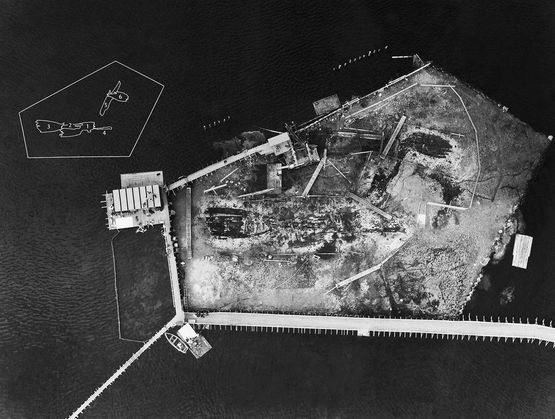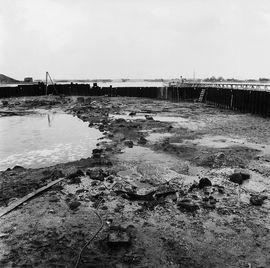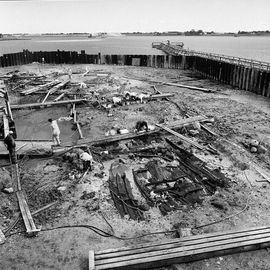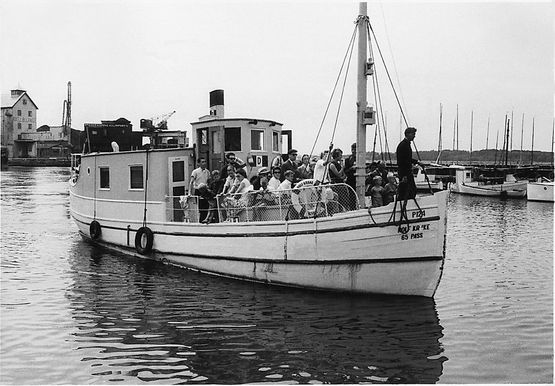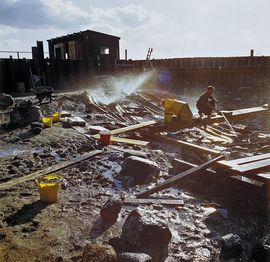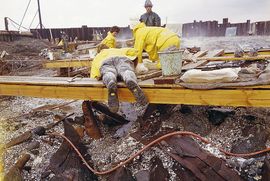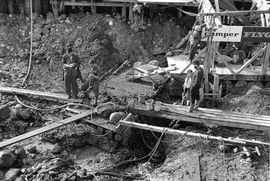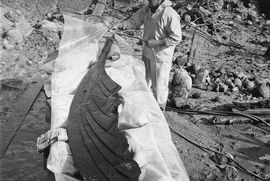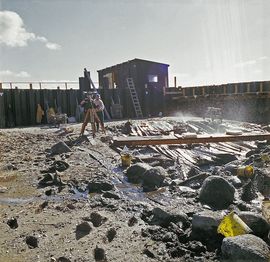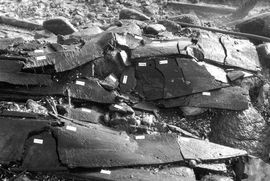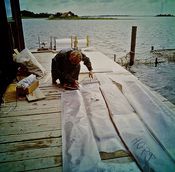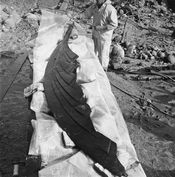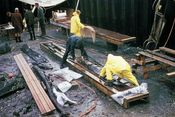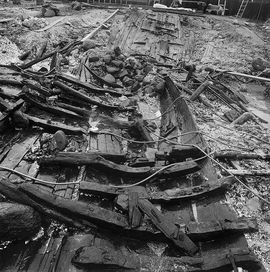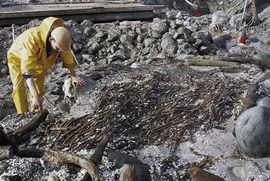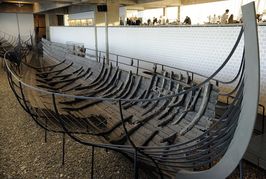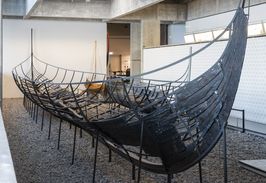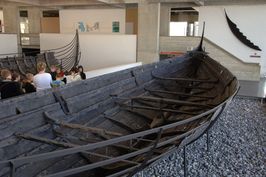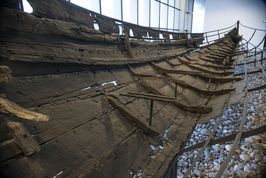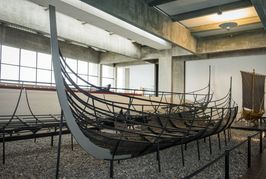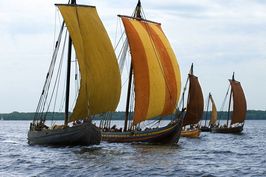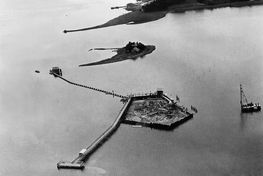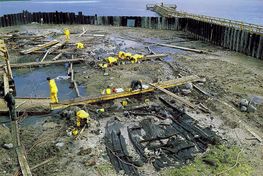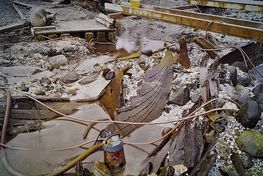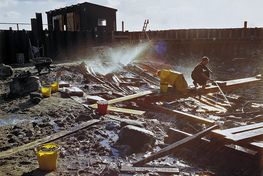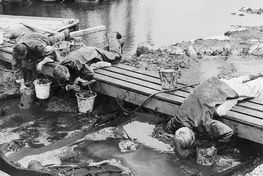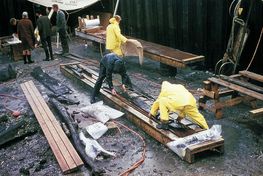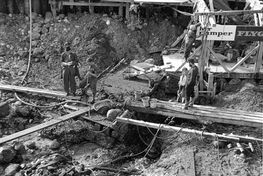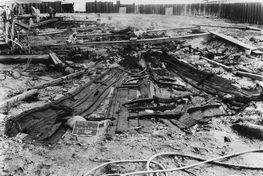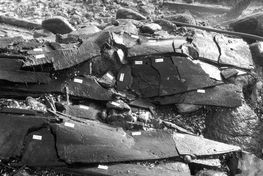The excavation of the 5 Skuldelev Ships
The miracle from Roskilde Fjord
60 years ago, one of the most groundbreaking archaeological excavations in Danish history began. After several years of preparations and minor diving investigations, the time had come to raise the newly found Viking ships from the bottom of Roskilde Fjord so that they could be examined and preserved for posterity.
The challenges were enormous. The risk was high. It was not at all certain it could be done.
But the goal was clear, and the project was carried by a boundless willpower and the combined efforts of many people.
On 5 July, 1962, everything was ready for the excavation and on 6 July, 1962, the pumps were turned on to gradually remove the water from the dammed-up area where the ships lay.
The difficult work to excavate the ships begins
It might have seemed practical initially to drain the whole area within the cofferdam so that the site could be excavated in the same way as on land. To do so would have had serious consequences, however, as the weight of the stones would have increased as the site was drained and they lost their buoyancy. The increased pressure from the stones within the ships themselves could damage and deform the ships’ soft timbers. In addition, it was of great urgency to prevent the drying out of the ships' timbers as long as they had not been conserved.
Therefore, the procedure involved the gradual lowering of the water level in the cofferdam until the most shallow parts of the site became visible. At the beginning of the excavation, the water level was only lowered about 75-80 cm. At this level it was possible to remove the top layer of materials in the barrier, such as bottom vegetation, some of the mud and stones, and whatever else might be covering the timbers. When this topmost layer had been removed, the water level was lowered once again by about ten centimeters until the bottom was again exposed. Then more sand, stones, etc., were removed and the procedure repeated several times until ships' parts or posts from the barrier were exposed and could be cleaned. In this way, we gradually made our way down into the barrier, and after a month, the water level had been reduced to 1.7 m below that of the water outside the cofferdam, and all of the five wrecks were partially exposed. As the wrecks were uncovered, a number of small garden-watering turbines were set up at various positions in the excavation area - at the height of our work there were 19 in operation - which kept all the wood moist with the aid of fjord water pumped by pumps on the outer side of the cofferdam.
The ships emerge
At the beginning of July 1962, Danish archaeologists embarked on an almost insurmountable task: They were to rescue the Viking ships that had been found in Roskilde Fjord some years earlier.
The area where the ships lay had been dammed in by the driven-in sheet piling to keep the fjord's water out of the excavation of the fragile ships, forming a cofferdam with an area of approximately 2,500 m2 - an artificial island in the fjord. Next to this, a small office building was constructed on posts in the water, and about 50 m further away a larger hut with a gangway to the excavation area was constructed to accommodate the team of workers. Along the one side of the wall of the cofferdam, a visitors' platform was erected that was connected by a gangway to a jetty for ships.
During the 1962 excavation period, a boat service was organized to bring visitors from Frederikssund to the site and back again after they had been given a conducted tour by one of the students describing the current progress of the work. A total of 28,000 persons visited the site via this route.
Woden bridges was necessary during the excavation
During the excavation, all ship parts had to be constantly sprayed with water so that they did not dry out and be destroyed before they could be preserved on land. This constant sprinkling was particularly important when there was strong sunshine. In that respect, however, there were seldom problems, since the summer of 1962 was unusually cold and rainy. This made it easier to maintain the necessary moisture in the excavation area.
In order to protect the timber, the excavators had to work while lying on narrow wooden bridges, 7-10 m long, that were laid out above the ship parts without touching the old wood. For safety reasons it was not advisable to use wheelbarrows on the slippery bridges. The excavated material had to be carried away in buckets or - in the case of the larger stones - in sacks.
In order not to damage the soft surfaces of the timber, no metal was allowed for the uncovering of the timber. Therefore, we bought a selection of kitchen scrapers and toy shovels made of soft plastic to be used instead of the normal archaeological trowels. These were hardly used, however, since the excavators soon discovered that the most expedient excavation tools were garden hoses with a trigger nozzle to control the force of the water jet. A strong jet could easily loosen the sand on the bottom that was often almost cemented together, while a more gentle spray could clean the surfaces of the timber more quickly and gently than would have been possible with even the softest sable brush.
The excavation
By the end of July 1962, after almost a month of hard work in a constantly humid environment, the archaeologists had largely uncovered the Viking ships within the dammed area that formed the excavation field in the middle of the fjord.
However, this was not the case in the sections of the barrier where the ships lay partially on top of each other. It rapidly became clear, however, that the barrier had been constructed in two phases: the first including the Skuldelev 1-ship, the Skuldelev 3-ship, and the Skuldelev 5-ship, the second including the Skuldelev 2-ship and the Skuldelev 6-ship.
The Skuldelev 2-ship was most damaged
The ships from the second phase, which layed on top of the barrier, were the ones most damaged by currents and ice-movement. In particular, the largest ship in the barrier - the Skuldelev 2-ship - was poorly preserved, even with the addition of the section that had earlier been wrongly classified as 'ship number 4'.
With the recognition that the found parts, which were classified as ship number 2 and ship number 4, actually were parts of the same ship the Skuldelev 2-ship, it was clear that the barrier consisted of five ships that back in the Viking Age had been filled with stones and sunken across the channel on the sailing route towards Roskilde.
After the sinking of the stone-laden ships, a large number of posts had been rammed down into the sea-floor, sometimes with wattles in between, in order to extend and strengthen the barrier.
A stem was completely intact
In the barrier, the Skuldelev 2-ship had offered protection to the Skuldelev 1-ship, lying below it in a good state of preservation. That the Skuldelev 3-ship would be the most complete ship in this excavation was known in advance, but this ship still gave the archaeologists some pleasant surprises, not least in that its stem proved to be completely intact. The ship was lying up against the edge of the channel so that the stem aft must have projected up above the surface of the water and had naturally been lost.
The Skuldelev 5-ship, which lay as it had capsized along the northern slope of the channel, confirmed our suspicion that most of its port side would be preserved, while the starboard side was almost entirely lost. The northern part of the Skuldelev 6-ship was very worn but the ship had broken across Skuldelev 5, and quite a lot of it had survived, resting against the edge of the channel.
At the beginning of the excavation, the ships emerged from the water as a large continuous 'bridge' over the channel, loaded with stones, filled with mud and overgrown with eelgrass and seaweed. After four weeks of excavation, parts of all the wrecks had been exposed by the two excavation teams working their way inward from both ends of the barrier.
Overall, the archaeologists could be satisfied with the course of the excavation. Now the measuring and registration of the find was to follow.
The documentation and registration
In the last days of July 1962, the archaeologists were able to look back on 4 weeks of successful excavation of the five Viking ships from Skuldelev. Now they were faced with the difficult task of documenting the many distorted ship parts. The important measuring and registration of the find was about to begin.
It quickly became clear that the traditional, archaeological methods of measurement would have taken too long time and been very difficult, because of the extent of the find, the many pieces of timber that comprised each ship, and the fact that the archaeologists could not tread on the ships while working. Therefore it was decided to use the photogrammetric method at the excavation.
The photogrammetric method of recording the ships ‘in situ’ – in place - overcame these problems completely. Photos were taken with double-cameras, recording the ships in relation to previously measured fixed points round about in the excavation area. The stereo photographs could later be used to record the ships very accurately.
Work in the field was restricted to the actual photography, while the plotting of the drawings could take place in the laboratory at the university.
Measurering process of the excavation
By count of the total number of hours spent, the photogrammetric measurements were hardly less time-consuming than a traditional measurement would have been.
For this excavation, however, it was of inestimable value that the measuring process on the excavation site could be carried out so rapidly, effectively, and with little risk of damage to the ship parts.
In addition to the stereo photographs used for measurement, a large number of detailed photographs of the ship parts were taken before they were taken up. These photos were on the one hand documentation of the ship parts and at the same time an aid to the later registration and numbering. A very comprehensive and thorough registration was absolutely necessary, since all the ships’ timbers had to be taken up piece by piece, often even in several fragments. A unique system was devised for documentation of all parts of the ships and this system later proved to be a great help, as the ships had to be reassembled after conservation.
Once the documentation, description and numbering of the exposed parts of a ship were completed, the salvage could begin, and the excavation and documentation of the ship parts below could then continue.
On 3 August, 1962, the excavation in its entirety and with all five ships exposed could be photographed from the air.
The salvaging
60 years ago, the archaeologists who were responsible for the excavation of the five Viking ships from Roskilde Fjord faced an incredibly demanding task.
They not only had to salvage 1000s of fragile ship parts from the bottom of Roskilde Fjord, but also had to develop a system to get all the ship parts - which could not withstand drying out - brought safely ashore and transported for conservation many kilometers from the excavation site.
The archaeologists were aware that all the timber would have to be packed in airtight plastic bags to prevent any drying during transport to the National Museum’s conservation workshop, where it was to be submerged in large water-filled tanks before the actual conservation. For packing, heavy-duty plastic bags in four widths between 25 and 55 cm had been purchased.
This plastic came in long rolls, from which bags in the desired lengths could be cut on the spot. For the very largest items that would not fit into the bags - mainly ship stems and keelsons - sheets of plastic foil in greater breadths were wrapped around the salvaged timbers and welded together.
Fragile planks
So far so good. It was evident, however, that problems would arise with the wreck pieces that were of species of timber other than oak. They were often so soft that even the lightest pressure could make a mark on them. Therefore, hardboards were sawn in the same shape and size as the fragile planks, which could then be carefully laid on their 'stretchers' as soon as they had been loosened from the bottom of the fjord.
Then the planks were cleaned and together with their 'stretchers', wrapped in burlap and placed in plastic bags that were sealed at both ends with electric welding nippers.
This process turned out to function very satisfactorily and it soon became the standard procedure for lifting all the pieces. Unlike the pieces of other wood species, all the wreck parts of oak were relatively well preserved. The centimeter-thin strakes had also retained their elasticity to an astonishing degree. Even though all the rivets had rusted away, however, it could be difficult to separate the strakes from one another. The caulking between the planks was still so adhesive that often several small pieces of the edges of the strakes broke off as they were being loosened. All these fragments were collected and laid in their correct position on the hardboard.
The amount of work this entailed is illustrated by the fact that the few ship parts were packed in a total of about 1,500 plastic bags with a total length of more than 4 km.
One or two lorry-loads of ship fragments everyday
As the team of students gradually became accustomed to the work process, they functioned almost as an assembly line, where each member had his or her regular position at registration, sawing out of hardboard, loosening of ships' timbers from the bottom of the fjord and lifting them over onto the hardboard, cleaning the planks, wrapping them in burlap, placing them in bags and welding the ends, and finally towing the rafts bearing the bags to the harbor in Skuldelev. From Skuldelev, for a long period, there were sent one or two lorry-loads of wreck fragments to the conservation workshop at Brede north of Copenhagen every day.
Everything was done so efficiently and conscientiously that hardly the tiniest piece of timber was lost in the course of this very comprehensive process.
It had been estimated from the outset that the excavation would take twelve weeks. This turned out to be nearly correct. On 28 September - after twelve weeks and one day - all the five ships had been salvaged and the team of students could be sent home.
The work inside the cofferdam, however, was not yet finished. It had been discovered that at the bottom of Peberholmshullet, the 4-5 m-deep hole immediately to the west of the barrier, there lay quite a large amount of ships' timbers that had been torn away from the wrecks by the currents and ice.
Meter-thick layer of mud
Some of these ships' parts were strake fragments but most of these were frame timbers, originating from the Skuldelev 2-ship situated on top of the barrier. It now all lay below a meter-thick layer of mud that first had to be shoveled away.
This last task was entrusted to a small team of workmen with experience in archaeological work, and they completed the task in three weeks. The culmination of this work was the discovery of the stem and the magnificent 14 m long two-part keelson of ship-find 2, which had to be hauled out of the mud.
On 17 October 1962, everything had been salvaged, the pumps were turned off, the team of workers left the excavation, and in the following weeks the sheet piling and all the technical installations were removed. Roskilde Fjord reverted to its normal condition - but without its five Viking ships.
Read more about the 5 Skuldelevships here
Skuldelev 1: The ocean-going trader
Skuldelev 1 is large ocean-going cargo ship from Sognefjord in western Norway. The ocean-going trader could have sailed all over the North Sea and the Baltic as well as in the North Atlantic.
Skuldelev 2: The great longship
Skuldelev 2 is a war machine, built to carry many warriors at high speed. Tree-ring analysis of the timber show that the ship was built of oak in the vicinity of Dublin around 1042.
Skuldelev 3: The coastal trader
Skuldelev 3 is a small, elegant and sturdy trading ship, built for transporting goods in Danish coastal waters and the Baltic. The ship is the best preserved of the five Viking ships found in Roskilde Fjord.
Skuldelev 5: The small longship
Skuldelev 5 is one of the smallest long ship in a war fleet, and is ideal for sailing in Danish coastal waters and through the short, choppy waves of the Baltic.
Skuldelev 6: The fishing vessel
Skuldelev 6 is a fishing boat, built in the Sognefjord area in western Norway - at the same time and place as the ocean-going trader Skuldelev 1.
The five reconstructions
The five Skuldelev ships were built and used by people who left innumerable traces in the vessels. The Viking Ship Museum's reconstructions are lying in the Museum Harbour, side by side with the traditional wooden boats.
Videos from the excavation at Skuldelev
The following videos are only available in Danish.
